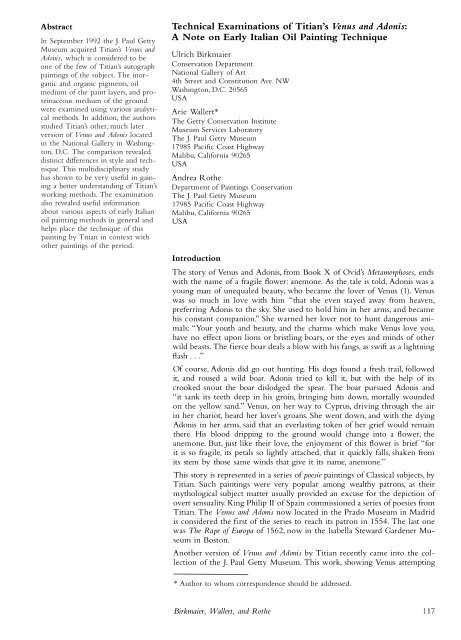Historical Painting Techniques, Materials, and Studio Practice
You also want an ePaper? Increase the reach of your titles
YUMPU automatically turns print PDFs into web optimized ePapers that Google loves.
Abstract<br />
In September 1992 the J Paul Getty<br />
Museum acquired Titian's VertUS <strong>and</strong><br />
Adonis, which is considered to be<br />
one of the few of Titian's autograph<br />
paintings of the subject. The inorganic<br />
<strong>and</strong> organic pigments, oil<br />
medium of the paint layers, <strong>and</strong> proteinaceous<br />
medium of the ground<br />
were examined using various analytical<br />
methods. In addition, the authors<br />
studied Titian's other, much later<br />
version of Venus <strong>and</strong> Adonis located<br />
in the National Gallery in Washington,<br />
D.c. The comparison revealed<br />
distinct differences in style <strong>and</strong> technique.<br />
This multidisciplinary study<br />
has shown to be very useful in gaining<br />
a better underst<strong>and</strong>ing of Titian's<br />
working methods. The examination<br />
also revealed useful information<br />
about various aspects of early Italian<br />
oil painting methods in general <strong>and</strong><br />
helps place the technique of this<br />
painting by Titian in context with<br />
other paintings of the period.<br />
Te chnical Examinations of Titian's Venus <strong>and</strong> Adonis:<br />
A Note on Early Italian Oil <strong>Painting</strong> Technique<br />
Ulrich Birkmaier<br />
Conservation Department<br />
National Gallery of Art<br />
4th Street <strong>and</strong> Constitution Ave. NW<br />
Washington, D.c. 20565<br />
USA<br />
Arie Wallert*<br />
The Getty Conservation Institute<br />
Museum Services Laboratory<br />
The J Paul Getty Museum<br />
17985 Pacific Coast Highway<br />
Malibu, California 90265<br />
USA<br />
Andrea Rothe<br />
Department of <strong>Painting</strong>s Conservation<br />
The J Paul Getty Museum<br />
17985 Pacific Coast Highway<br />
Malibu, California 90265<br />
USA<br />
Introduction<br />
The story of Venus <strong>and</strong> Adonis, from Book X of Ovid's Metamorphoses, ends<br />
with the name of a fragile flower: anemone. As the tale is told, Adonis was a<br />
young man of unequaled beauty, who became the lover of Venus (1). Venus<br />
was so much in love with him "that she even stayed away from heaven,<br />
preferring Adonis to the sky. She used to hold him in her arms, <strong>and</strong> became<br />
his constant companion." She warned her lover not to hunt dangerous animals:<br />
"Your youth <strong>and</strong> beauty, <strong>and</strong> the charms which make Venus love you,<br />
have no effect upon lions or bristling boars, or the eyes <strong>and</strong> minds of other<br />
wild beasts. The fierce boar deals a blow with his fangs, as swift as a lightning<br />
flash ..."<br />
Of course, Adonis did go out hunting. His dogs fo und a fresh trail, followed<br />
it, <strong>and</strong> roused a wild boar. Adonis tried to kill it, but with the help of its<br />
crooked snout the boar dislodged the spear. The boar pursued Adonis <strong>and</strong><br />
"it sank its teeth deep in his groin, bringing him down, mortally wounded<br />
on the yellow s<strong>and</strong>." Venus, on her way to Cyprus, driving through the air<br />
in her chariot, heard her lover's groans. She went down, <strong>and</strong> with the dying<br />
Adonis in her arms, said that an everlasting token of her grief would remain<br />
there. His blood dripping to the ground would change into a flower, the<br />
anemone. But, just like their love, the enjoyment of this flower is brief "for<br />
it is so fragile, its petals so lightly attached, that it quickly falls, shaken from<br />
its stem by those same winds that give it its name, anemone."<br />
This story is represented in a series of poesie paintings of Classical subjects, by<br />
Titian. Such paintings were very popular among wealthy patrons, as their<br />
mythological subject matter usually provided an excuse for the depiction of<br />
overt sensuality. King Philip II of Spain commissioned a series of poesies from<br />
Titian. The Venus <strong>and</strong> Adonis now located in the Prado Museum in Madrid<br />
is considered the first of the series to reach its patron in 1554. The last one<br />
was The Rape oj Europa of 1562, now in the Isabella Steward Gardener Museum<br />
in Boston.<br />
Another version of Venus <strong>and</strong> Adonis by Titian recently came into the collection<br />
of the J. Paul Getty Museum. This work, showing Venus attempting<br />
* Author to whom correspondence should be addressed.<br />
Birkmaier, Wallert, <strong>and</strong> Rothe 117


